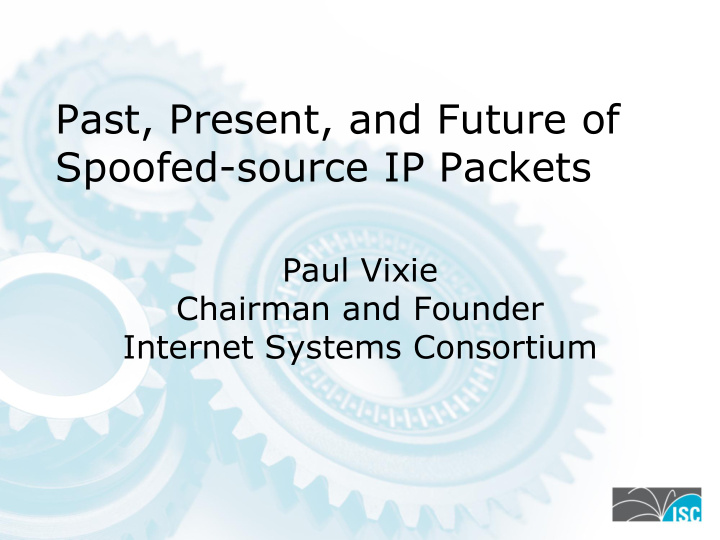



Past, Present, and Future of Spoofed-source IP Packets Paul Vixie Chairman and Founder Internet Systems Consortium
Overview • IP Spoofing: the root of most evil • DNS RRL: radical DDoS opt-out
Spoofed Source Attacks: Essence attacker (target) Src addr: Internet target Dst addr: (target) reflecto r
Spoofed Source Attacks: Past attacker Botted PC, behind NAT, (target) Src addr: Megabit speed Internet target Dst addr: (target) reflecto r
Spoofed Source Attacks: Present attacker Botted server, in the cloud, (target) Src addr: Gigabit speed Internet target Dst addr: (target) reflecto r
Spoofed Source Attacks: Future attacker Botted phone or refrigerator, (target) Src addr: Gigabit speed Internet target Dst addr: (target) reflecto r
Crazy Lessons of History • Wide area UDP services must never amplify – In this light, DNS was crazy – And: DNSSEC is even crazier – But: NTP is (strangely) OK • Promoting data to executable code is crazy – Like: Java, Flash, ActiveX, Autorun, JavaScript, or the conficker worm’s “click to permit” hack • Expecting users to be sysadmins is crazy – Like: PC, Mac, cloud servers, smart phones
Action Items for Industry • All recursive name servers need access control – They should only answer for their customers • All authority name servers need rate limiting – Quickly repeated responses are never necessary • Edge networks should validate their src addrs – This can’t be done closer to the Internet “core” • Cloud/VM providers should offer sys admin – Webmasters can’t be expected to update Joomla • References – BCP38, “Network Ingress Filtering”, 2000 – SAC004, “Securing the Edge”, 2002
RRL On The Wire [nsa:amd64] repeat 25 \ dig +novc +ignore +retries=0 +time=1 vix.com aaaa \ @ns.sql1.vix.com \ | grep tc ;; flags: qr aa tc rd ad; QUERY: 1, ANS: 0, AUTH 0, ADD: 1 ;; flags: qr aa tc rd ad; QUERY: 1, ANS: 0, AUTH: 0, ADD: 1 ;; flags: qr aa tc rd ad; QUERY: 1, ANS: 0, AUTH: 0, ADD: 1
RRL Configuration options { directory "/var/local/named"; pid-file "/var/run/named-nsa.pid"; query-source address 149.20.48.227 port *; listen-on-v6 { ::1; 2001:4f8:3:30::3; }; listen-on { 127.0.0.1; 149.20.48.227; }; recursion yes; notify yes; dnssec-enable yes; dnssec-lookaside . trust-anchor dlv.isc.org.; dnssec-validation yes; rate-limit { responses-per-second 5; window 5; }; };
Using RRL In Your Servers • In authority servers – RRL has no negative impact on real flows, because real clients have caches, will retry with UDP, will try TCP if given a truncated response • In recursive servers – RRL would have a negative impact on real flows, because real clients do not have caches – It should not be necessary, just use ACLs
RRL In Action: Afilias
Final Thoughts: DNS RRL • RRL was first implemented in BIND but is intended for use in all name servers • NSD added it in 3.2.15, February 2012 • Please study the DNS RRL specification carefully, it’s intended to be implemented literally • Specification, patches, pointers, and specification are available online – http://www.redbarn.org/dns/ratelimits
Final Thoughts: IP Spoofing • Economics at the edge aren’t just misaligned, they’re pessimal • There will always be spoofing, although regulation isn’t impossible • Meanwhile we have to get rid of all DDoS amplifiers • Fortunately, the economics are better aligned for this
Recommend
More recommend